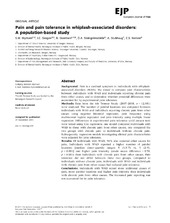| dc.contributor.author | Myrtveit, Solbjørg Makalani | en_US |
| dc.contributor.author | Skogen, Jens Christoffer | en_US |
| dc.contributor.author | Sivertsen, Børge | en_US |
| dc.contributor.author | Steingrímsdóttir, Ólöf Anna | en_US |
| dc.contributor.author | Stubhaug, Audun | en_US |
| dc.contributor.author | Nielsen, Christopher Sivert | en_US |
| dc.date.accessioned | 2016-03-23T09:55:06Z | |
| dc.date.available | 2016-03-23T09:55:06Z | |
| dc.date.issued | 2015 | |
| dc.Published | European Journal of Pain 2015 | eng |
| dc.identifier.issn | 1090-3801 | |
| dc.identifier.uri | https://hdl.handle.net/1956/11745 | |
| dc.description.abstract | Background: Pain is a cardinal symptom in individuals with whiplash-associated disorders (WAD). We aimed to compare pain characteristics between individuals with WAD and individuals reporting chronic pain from other causes, and to determine whether potential differences were accounted for by experimental pain tolerance. Methods: Data from the 6th Tromsø Study (2007–2008, n = 12,981) were analysed. The number of painful locations was compared between individuals with WAD and individuals reporting chronic pain from other causes using negative binomial regression, pain frequency using multinomial logistic regression and pain intensity using multiple linear regression. Differences in experimental pain tolerance (cold pressor test) were tested using Cox regression; one model compared individuals with WAD to those with chronic pain from other causes, one compared the two groups with chronic pain to individuals without chronic pain. Subsequently, regression models investigating clinical pain characteristics were adjusted for pain tolerance. Results: Of individuals with WAD, 96% also reported other causes for pain. Individuals with WAD reported a higher number of painful locations [median (inter-quartile range): 5 (3.5–7) vs. 3 (2–5), p < 0.001] and higher pain intensity (crude mean difference = 0.78, p < 0.001) than individuals with chronic pain from other causes. Pain tolerance did not differ between these two groups. Compared to individuals without chronic pain, individuals with WAD and individuals with chronic pain from other causes had reduced pain tolerance. Conclusions: Individuals with WAD report more additional causes of pain, more painful locations and higher pain intensity than individuals with chronic pain from other causes. The increased pain reporting was not accounted for by pain tolerance. | en_US |
| dc.language.iso | eng | eng |
| dc.publisher | Wiley | eng |
| dc.relation.uri | http://onlinelibrary.wiley.com/doi/10.1002/ejp.819/pdf | |
| dc.rights | Attribution CC BY | eng |
| dc.rights.uri | http://creativecommons.org/licenses/by/4.0/ | eng |
| dc.title | Pain and pain tolerance in whiplash-associated disorders:A population-based study | en_US |
| dc.type | Peer reviewed | |
| dc.type | Journal article | |
| dc.date.updated | 2015-12-01T09:27:22Z | |
| dc.description.version | publishedVersion | en_US |
| dc.rights.holder | Copyright 2015 The Authors | |
| dc.identifier.doi | https://doi.org/10.1002/ejp.819 | |
| dc.identifier.cristin | 1291949 | |

